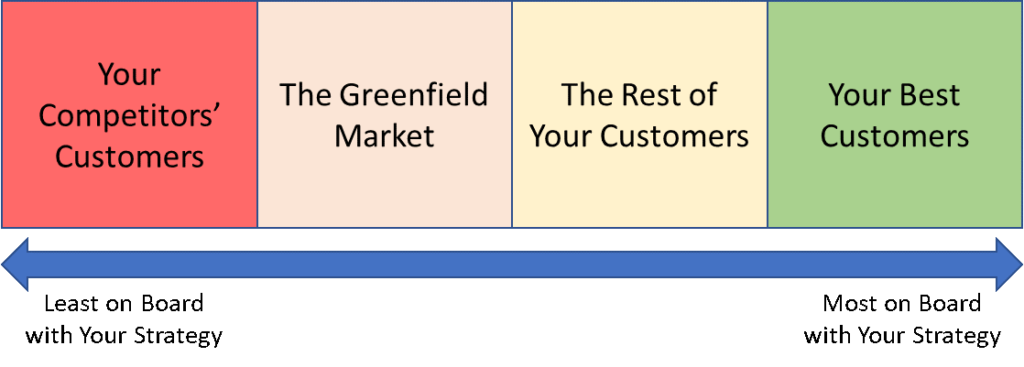If your company is like most B2B technology companies, you probably have a Customer Advisory Board (CAB). Usually consisting of top executives from 20 or so of your top customers, the CAB meets once or twice a year, where interspersed with the wining and dining, the members talk about market trends, discuss their needs and provide feedback on the company’s strategy and roadmap.
CAB’s are generally considered the gold standard for getting strategic customer feedback. What could possibly be more insightful and more valuable than the guidance of 20 senior executives from your best customers?
Actually – a lot of things.
While there is no question that building close relationships with your top customers via a CAB is a good thing, from a strategy perspective, they could be leading you down the wrong path.
At Topline, one of the key methodologies we use to develop market strategies is to systematically gather input from accounts that have different relationships with our client. Roughly, relationships can be categorized into four groups, ranging from those with the closest to those with the most distant:
- Your Best Customers, who are your true believers
- The Rest of Your Customers, who are working with you, but are not as invested in your company as your best customers
- The Greenfield Market, companies that could be your future new logos, but haven’t yet aligned with any vendor in the market.
- Your Competitors’ Customers, who are invested in one of your competitors
Companies’ Relationships with Accounts Divide into Four Groups
Here is the problem: The members of your CAB all belong to the same group – your best customers. These customers are your best customers for a reason – they have bought into your vision and are heavy users of your technology. Furthermore, the longer they have been your customers, and usually CABs are comprised of long standing customers, the less they look and act like the rest of the market. As a result, you cannot rely on what they say as being representative of anything other than themselves.
- They will ask for things that the rest of the market doesn’t care about, causing you to invest heavily in capabilities for them that only a fraction of the rest of the market really needs.
- Because how they do business has been shaped by your technology, they can fail to recognize trends that are crucial to the other groups of customers.
The problem is then made worse by the fact that CABs are one of the few times executive teams, from the CEO on down, get together as a group to listen to customers. While it is hard for feedback from individual customer meetings attended by one or perhaps two executives to break through, it is easy for senior leadership to rally behind the shared experience of what they heard at the CAB. As a result, the feedback from CAB meetings play an outsized role in setting companies’ strategy and direction.
The net result is that by listening too closely to your CAB, your company can follow those customers down the wrong path instead of pursuing the critical growth opportunities that come from meeting the needs of accounts in these other groups such as:
- Increasing your position in your next tier of customers
- Winning more than your fair share of greenfield accounts
- Disrupting your competitors and winning over their customers
Who Doesn’t Have to Worry
There is one class of companies that don’t have to worry about getting a skewed perspective from CABs – companies that dominate niche markets. For example, if your company specializes in technology for the pharmaceutical industry and your CAB includes Merck, Eli Lilly, Novartis, Pfizer and 10 to 15 of the other top firms, then there is really no chance of getting misled. Your CAB is the market.
If you do not fall into this exception, then this is very much something you need to worry about.
What to Do About It
As we stated above, despite these potential drawbacks, CABs are still highly worthwhile as a way to build relationships with your best customers. The trick is to balance the feedback from the CAB with feedback from each of these constituencies. Furthermore, this feedback needs to be gathered and analyzed systematically. Otherwise, it just will get lost in the shuffle. Examples of systematic feedback include:
- Executive interview programs that reach a cross-section of accounts that are not on the CAB
- Broad based market research to keep tabs on the larger market
- Win/Loss analysis programs that reach a critical mass of accounts who opted for competitors instead of you
Finally, all of these inputs need to be weighed against each other and assembled into a plan that maximizes the company’s total opportunity.
Need help with getting systematic input from across the market and turning it into a winning plan? Let us know. You can email us at info@toplinestrategy.com or contact us.

